The high sensitivity, ultra-low noise performance of Andor Technology's vacuum Thermoelectric (TE) cooled CCD and Electron Multiplying CCD (EMCCD) cameras is well suited to a diversity of demanding astronomy applications.
The industry-leading TE vacuum cooling of the large area iKon CCD range, enable extensive field of view observation, coupled with long exposure times for deep space imaging. EMCCD technology (in the form of Andor's award-winning iXon EMCCD camera series) has proven highly effective for Single Photon Counting, Lucky Astronomy and also Adaptive Optics.
Now, Andor have brought EMCCD single photon sensitivity to the mainstream astronomy community.
EMCCD vs Conventional CCD
The choice whether or not to opt for EMCCD for astronomy depends very much on your ability to employ longer exposure times to collect enough signal.
The rule of thumb is that if long exposures and slower pixel readout speeds can routinely be employed, such that enough photons can be collected to significantly overcome the read noise floor, then a low-noise, deep-cooled, back illuminated iKon slow-scan camera platform is recommended.
Finally, it should be remembered that EMCCDs can essentially be made single photon sensitive and can even be used to count individual photons!
Andor Solutions for Astronomy
iXon EMCCD camera series, and the Newton spectroscopy EMCCD platform, all offer single photon sensitivity combined with high Quantum Efficiency (QE) at multi-MHz rapid readout speeds.
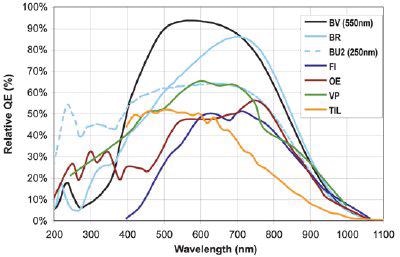
QE curves relevant to Astronomy
iXon EMCCD Camera Series
Andor's pioneering iXon EMCCD camera series is a revolutionary camera range that provides single photon detection sensitivity, highest QE and -100°C cooling at rapid frame rates, utilizing Andor's pioneering and award-winning EMCCD technology.
The iXon EMCCD camera series is ideal for dynamic applications such as Lucky Astronomy and Adaptive Optics. The low-noise photon counting capabilities of the DU-897 can be harnessed to overcome multiplication noise. The DU-888 back illuminated, with 1024 x 1024 13µm pixels, offers an excellent combination of sensitivity and field of view. Andor-exclusive Real Gain™ sets the new standard in day-to-day EMCCD usage.
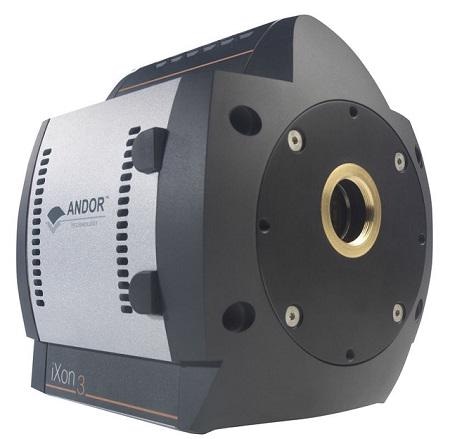
iXon EMCCD camera series
Features and Benefits of the iXon EMCCD Camera Series
Features and Benefits of the iXon EMCCD camera series include:
- Single photon sensitivity + high QE (> 90% available)
- RealGain™: easily tune gain multiplication factor to balance signal amplification vs dynamic range.
- Single photon counting capability from industry: leading minimization of dark noise events.
- Faster frame rates: 1000 x 1000 @ 30 frames/sec to 128 x 128 @ > 500 fps.
- Minimized darkcurrent from unparalleled -100°C TE cooling
- EMCCD and Conventional amplifiers: operate at fast frame rate with EM gain, or as classic slow readout CCD for longer exposures
iXon EMCCD Camera Series
For photon counting we invariably recommend iXon EMCCD camera series DU-897 back illuminated EMCCD. The dark current and clock induced charge levels are the lowest available on the market.
For imaging techniques that are fundamentally restricted by background photons the level of darkcurrent at shorter exposure times can be less critical, being masked by the photon background level. Consequently, iXon EMCCD camera series cameras can be used to deliver enhanced EMCCD performance at high imaging rate, the choice depending on a number of factors such as:
- QE requirement: the highest QE's improve Signal to Shot noise (Poisson noise) ratio
- Sensor format
- Frame rate: the absolute fastest pixel speeds are still from the iXon 35 MHz PCI-Express platform
- PCI v USB
- Number of cameras required
Photon Counting with the iXon EMCCD Camera Series + DU897E-CSO-BV
In order to effectively harness EMCCD technology to levels where photon counting is possible, a number of key parameters must be addressed and optimised during camera design to deliver a truly high-end system. The pioneering iXon EMCCD camera series range was designed from first principles to maximize the potential that this new technology promised.
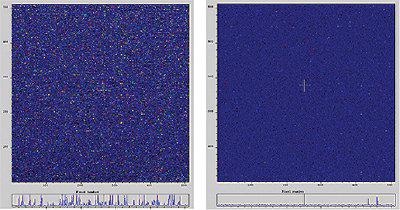
Photon counting screenshots: Left = -30°C (x1000 EM Gain), right =-80°C (x1000 EM gain)
An area that requires particular attention for optimising EMCCD performance is that of TE cooling. By housing the sensor into a hermetically sealed, permanent vacuum enclosure, designed also for absolute minimization of out-gassing (rather than the lower-end approach of an o-ring sealed, gas-filled housing), it is possible to achieve significantly lower temperatures in any ambient condition (down to -100°C).
Enhanced cooling performance is desireable in EMCCD technology, since thermally generated electrons are amplified above the read noise floor, just as photoelectrons will be. It is thus crucial to minimize darkcurrent as far as possible, even under rapid frame rates, for true photon counting capability.
Another parameter of EMCCD performance that requires considerable attention is the area of charge shifting. It is beneficial in a frame transfer device to offer the ability and flexibility to push vertical clock times as fast as possible, thus (a) minimizing smearing under short exposure times and (b) increasing frame rate.
The challenge comes in doing this whilst retaining the essential sensitivity performance, since a form of spurious single electron noise called Clock Induced Charge (CIC) is particularly sensitive to clock conditions. It is through careful optimization of voltage clocking parameters, that the EMCCD can be operated successfully under these more challenging conditions.
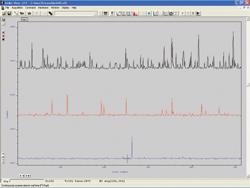
Dark images and corresponding line profiles taken with the iXon EMCCD camera series DU897 (containing the E2V CCD97-00 L3 sensor) at x1000 EM gain, 30 ms exposures, with three differentcooling temperatures. Black -30°C, Red -50° C & Blue -70°C.
The effect of EM-amplified darkcurrent is evident, even under conditions of short exposures. Deep cooling performance and minimization of CIC is critical for effective photon counting experiments with EMCCDs.
Newton
Andor's pioneering Newton is a revolutionary range of high-end spectroscopy EMCCD/CCD cameras that provide single photon detection sensitivity, back illuminated QE, and -90°C cooling at rapid frame rates. USB 2.0 connectivity provides plug and play operation.
Features and Benefits of the Newton
Features and Benefits of the Newton include:
- Single photon sensitivity + QE > 90%
- Detection of extremely weak spectral signals with optimal Signal to Noise (S/N) and high spectral resolution
- RealGain™
- Faster spectral rates
- USB2.0
- USB 2.0 extender: transmit data over long distances direct from camera to PC
- Minimized darkcurrent from unparalleled -90°C TE cooling: especially critical for full vertical binning.exposures.
- EM and Conventional amplifiers: operate at fast frame rate with EM gain, or as classic slow readout CCD for longer exposures
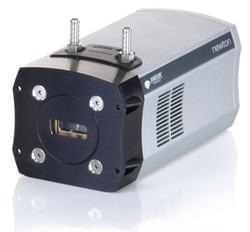
Newton
Interface Requirements for Adaptive Optics
The advent of EMCCD has pushed small size EMCCD sensors, such as the E2V CCD60, into the Adaptive Optics arena. However, in Adaptive Optics the data must be analysed in real time, and the standard PC is simply not good enough. Andor is working with several groups in this field and has designed different solutions to getting the data from the camera to the 3rd party DSP controllers with minimal delay.
For those requiring the data to be transferred over short distances a small repeater/splitter has been developed. While for those requiring the data to be transferred over longer distances Andor has developed a solution using a fibre optic Serial FPDP design.
Andor CCDs for Astronomy
iKon-L
Andor's iKon-L is a revolutionary large area CCD platform, offering back illuminated (> 90% QE) full frame sensors up to 4MPixel(2k x 2k), 1 MHz readoutand unparalleled priority TE cooling down to -100°C.
For astronomy we recommend the iKon-L DW-436 or iKon-L DZ-436. These back illuminated 2k x 2k cameras combine low noise readout of 2 to 3 electrons rms, > 90% QE with the exceptionally low darkcurrent enabled by Andor's exclusive 5- stage large area TE cooler.
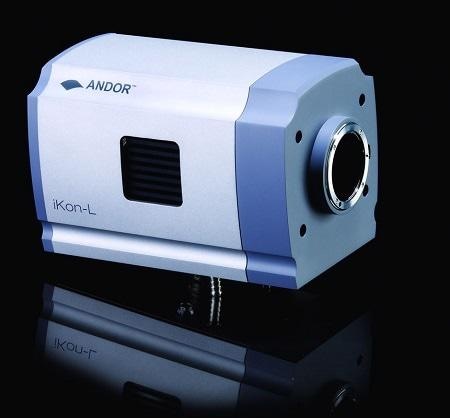
iKon-L
Features and Benefits of the iKon-L
Features and Benefits of the iKon-L include:
- Large sensor platforms: large field of view and high pixel resolution (E2V 42-40 - 2k x2k).
- QE > 90%: few photons wasted resulting in higher signal to shot noise ratio.
- Detection of extremely weak signals with optimal S/N
- Exceptionally low darkcurrent from -70°C (DW model) or -100°C (DZ model)* TE cooling: ideal for longer exposures and slow readout selection (for lower readout noise)
- *No other manufacturer has the capability to thermoelectrically cool such a large area sensor to -100°C
iKon-M
Andor's iKon-M CCD range offers affordable, yet unmatched sensitivity for slow scan astronomy. The iKon-M platform houses a range of full frame and frame transfer sensors, in both front illuminated and back illuminated (> 90% QE) varieties.For astronomy we recommend the iKon-M DU-934N-BV. This back illuminated 1k x 1k camera, with 13µm2 pixels, offers low readout noise of 2 to 3 electrons rms, > 90% QE and -100°C TE cooling, sensitivity performance that remains unmatched in the market.
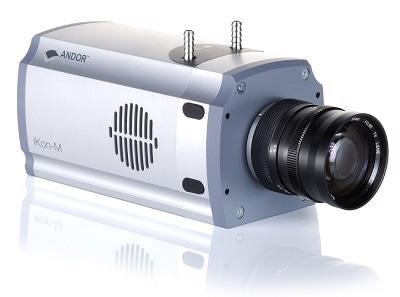
iKon-M
Features and Benefits of the iKon-M for Astronomy
Features and Benefits of the iKon-M for Astronomy include:
- QE > 90%: back illumination for maximum photon capture and higher S/N ratio
- Advanced TE cooling down to -100ºC: ideal for longer exposures
- Ultra low-noise readout: intelligent low-noise electronics offer the most "silent" system noise performance available from these sensors
- Software selectable readout speeds (up to 2.5MHz): faster readout for focusing, slower readout for absolute minimal noise performance during acquisition
- High dynamic range: single acquisition 16 bit.
- USB 2.0 connectivity: Plug and play. Long distance connection via USB Extender
iDus
Andor's iDus is a range of affordable yet high-end spectroscopy CCD cameras that house a range of sensor formats, both front and back illuminated, offering vacuum TE cooling to -90°C. USB 2.0 connectivity provides plug and play operation.
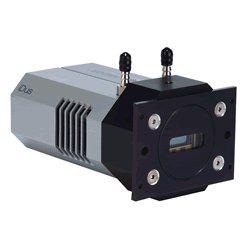
iDus
Features and Benefits of the iDus
Features and Benefits of the iDus include:
- QE > 90% available
- Detection of extremely weak spectral signals with optimal S/N and high spectral resolution
- Minimized darkcurrent from unparalleled -90°C TE cooling
- USB 2.0
- USB 2.0 extender: transmit data over long distances direct from camera to PC
iKon-XL 231 - The Definitive Astronomy CCD Camera
The latest iKon-XL from Andor is a TE-cooled, very large area CCD camera platform. It houses large field of view sensors, which are suitable for long exposure astronomy applications.
The patent-pending ColdSpace™ technology is used for thermoelectrically cooling a back-illuminated 16.8MP sensor (e2v) down to a temperature of -100°C, thereby eliminating the use of liquid nitrogen or cryo-coolers. With 18-bit digitization capability, the platform has extended dynamic range.
The iKon-XL 231 model makes use of the e2v CCD231-84 ‘astro’ back-illuminated sensor, thus integrating very low read noise of 2.1 e- with 350,000 e- well depth and is offered with various sensor QE coatings, in both standard and deep depletion formats.
The following are the key features of the iKon-XL:
- Extended dynamic range (18-bit)
- 100°C TE cooled large area sensors
- e2v CCD231-84 sensor (deep depletion available)
- Does not require liquid nitrogen or cryo-cooler

This information has been sourced, reviewed and adapted from materials provided by Andor Technology Ltd.
For more information on this source, please visit Andor Technology Ltd.